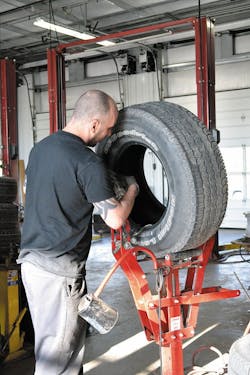The Tread Rubber and Tire Repair Materials Manufacturers Group (TRMG) has released additional Recommended Practices (RPs) for retreading and repairing through the Tire Retread & Repair Information Bureau (TRIB) website. The RPs are free to view on TRIB’s website, www.retread.org.
TRIB says customers wanting to download a PDF version or receive hard copies of the RPs can do so through its online store for a small fee.
“TRIB is glad to continue our partnership with TRMG to distribute these important documents,” says TRIB Managing Director David Stevens. “Now, retreaders and tire repair companies all over the world will have free access to the best practices for tire retreading and proper tire repair.”
There are two size guideline charts for radial light truck tire repair. For fabric light truck tires up to but not including Load Range E sizes, the size guidelines are:
- 6.50-12.50 • 215/85 to 255/85 • 215/75 to 265/75.
For steel or similar material body ply light truck tires Load Range E and above (highway service), the size guidelines are:
- 225/75R16 to 245/75R17.
The size dimensions shown are for general guidance, according to TRMG. “Repair material manufacturers’ and new tire manufacturers’ recommendations may differ. Specific limits should be based on recommendations of the tire manufacturer, repair material manufacturer and type of tire service.”
(For sizes not covered, TRMG says consult the tire or repair material manufacturer.)
Puncture repairs
The big difference between light truck tires below Load Range E and LT tires Load Range E and above is the size of the permissible puncture repair. Both repairs should be limited to the tread area only, but light truck radial fabric body ply tire puncture repairs should not exceed 1/4 inch (6.0 mm) in diameter after preparation.
For light truck radial steel body ply tires, the puncture repair should not exceed 3/8 inch (10.0 mm) in diameter after preparation.
Cleaning tip
TRMG recommends removing all contaminants from around the injury. However, this has become more problematic with the increased popularity of puncture sealants. Whether they are purchased in the aftermarket or come with vehicles without spares, they also need to be removed.
Here’s what TRMG has to say about the matter.
“Tires that contain any type of aftermarket puncture sealant(s) may have been damaged as a result of being run under-inflated and/or overloaded, and should be inspected accordingly.”
What about tires designed with puncture sealing? TRMG also addresses that situation.
“Tires that are manufactured with puncture sealing capabilities require specialized repair techniques. The tire and/or sealant manufacturers should be contacted for recommendations. It may be necessary to repeat (the pre-cleaning process) to ensure that the repair area is free of contaminants.” ■
Key repair terminology: from buff contour to buffing template
Whether attempting a minor rubber repair (the only time a repair can be made in the bead area), puncture/nail hole repair or section repair, one of the key steps involves buffing. Here is a glossary of buffing terms, courtesy of the Tread Rubber and Tire Repair Materials Manufacturers’ Group.
Buff contour: the specified shape of a buffed area.
Buff(ing): removal of the previously vulcanized rubber surface.
Buff line: the dividing line in the cross section of a tire between the buffed surface of the original tire and the new retread rubber.
Buffed radius: a measurement of the buffed surface curvature from shoulder to shoulder.
Buffed surface: a specifically prepared surface of a tire casing or repair area to provide proper texture to help promote adhesion to the new rubber.
Buffed texture: that surface produced by buffing, rasping or cutting as standardized by the Rubber Manufacturers Association.
Buffer: a machine used to rasp the old tread from the casing. A powered rotary rasp provides a clean, even surface for adhesion of the new tread rubber.
Buffing template: a machined device of a specified shape used to obtain the required buffed tire radius.
About the Author

Bob Ulrich
Bob Ulrich was named Modern Tire Dealer editor in August 2000 and retired in January 2020. He joined the magazine in 1985 as assistant editor, and had been responsible for gathering statistical information for MTD's "Facts Issue" since 1993. He won numerous awards for editorial and feature writing, including five gold medals from the International Automotive Media Association. Bob earned a B.A. in English literature from Ohio Northern University and has a law degree from the University of Akron.
